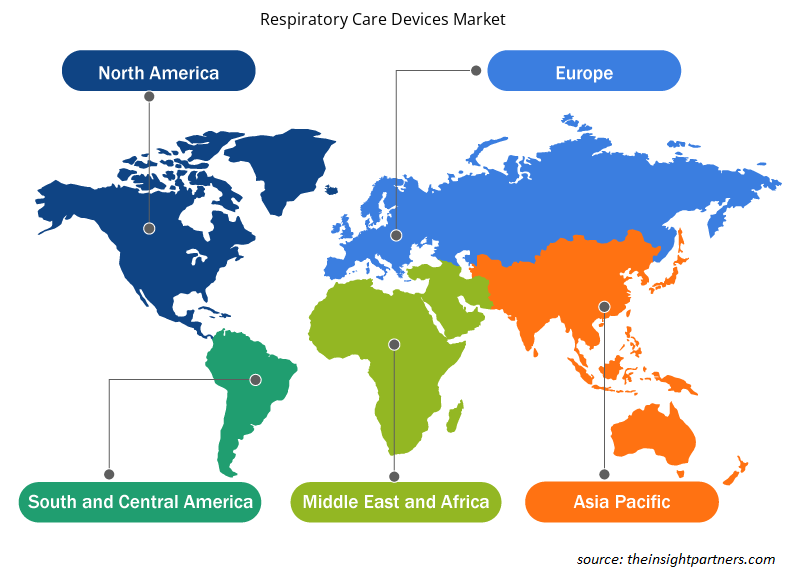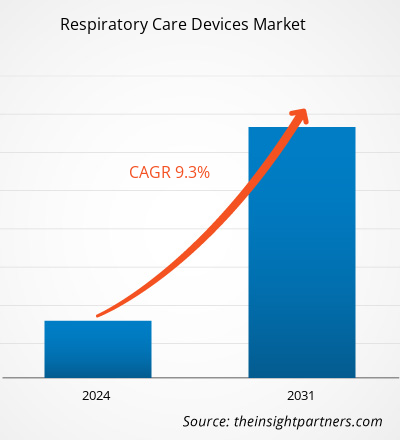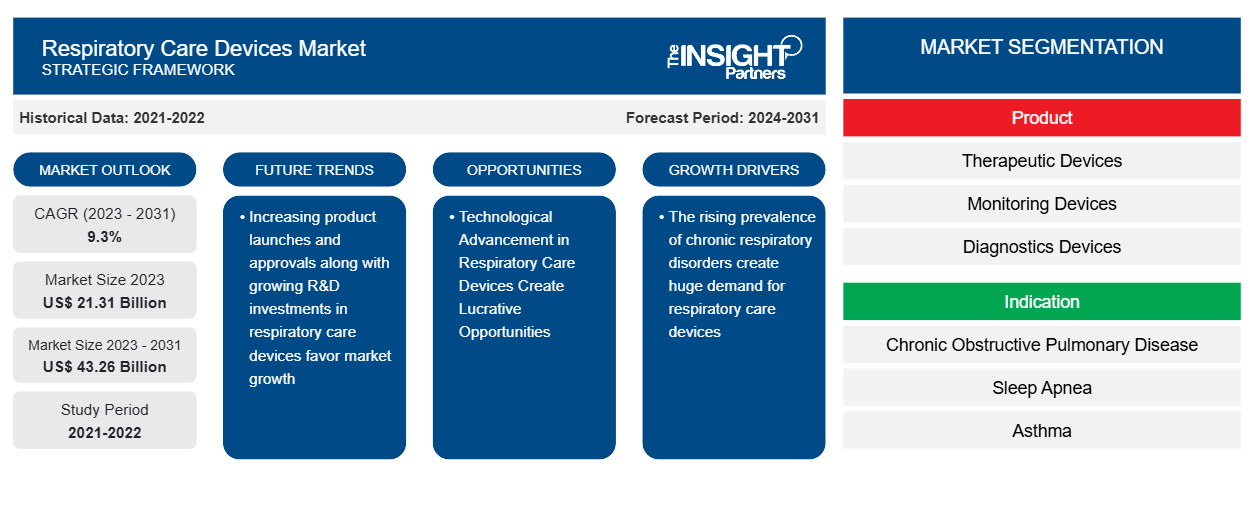من المتوقع أن يصل حجم سوق أجهزة رعاية الجهاز التنفسي إلى 43.26 مليار دولار أمريكي بحلول عام 2031 من 21.31 مليار دولار أمريكي في عام 2023. ومن المتوقع أن يسجل السوق معدل نمو سنوي مركب بنسبة 9.3٪ خلال الفترة 2023-2031. ومن المرجح أن يظل التبني المتزايد لأجهزة رعاية الجهاز التنفسي المحمولة / الرقمية والتحول النموذجي نحو حلول التكنولوجيا القائمة على القيمة من الاتجاهات الرئيسية في السوق.
تحليل سوق أجهزة العناية التنفسية
إن الانتشار المتزايد لأمراض الجهاز التنفسي مثل مرض الانسداد الرئوي المزمن والربو والإنفلونزا وغيرها والعدد المتزايد من عمليات إطلاق المنتجات والموافقات عليها إلى جانب ضمان استثمارات البحث والتطوير في أجهزة رعاية الجهاز التنفسي هي العوامل الرئيسية التي تدفع نمو سوق أجهزة رعاية الجهاز التنفسي. بالإضافة إلى ذلك، من المتوقع أن يخلق الطلب المتزايد على أجهزة الرعاية الصحية المنزلية والتقدم التكنولوجي في أجهزة رعاية الجهاز التنفسي فرصًا مربحة لنمو السوق. علاوة على ذلك، فإن التبني المتزايد لأجهزة رعاية الجهاز التنفسي المحمولة / الرقمية والتحول النموذجي نحو حلول التكنولوجيا القائمة على القيمة هي العوامل السائدة التي تساهم في نمو السوق.
نظرة عامة على سوق أجهزة العناية التنفسية
إن سوق أجهزة رعاية الجهاز التنفسي مدفوع بالانتشار المتزايد لأمراض الجهاز التنفسي مثل مرض الانسداد الرئوي المزمن والربو والإنفلونزا وغيرها وزيادة عدد عمليات إطلاق المنتجات والموافقات عليها إلى جانب ضمان استثمارات البحث والتطوير في أجهزة رعاية الجهاز التنفسي. بالإضافة إلى ذلك، من المتوقع أن يخلق الطلب المتزايد على أجهزة الرعاية العلاجية المنزلية والتقدم التكنولوجي في أجهزة رعاية الجهاز التنفسي فرصًا مربحة لنمو السوق. سيطرت أمريكا الشمالية على سوق أجهزة رعاية الجهاز التنفسي والولايات المتحدة تقود سوق أمريكا الشمالية. خلال جائحة كوفيد-19، اتخذت إدارة الغذاء والدواء الأمريكية (FDA) إجراءات مهمة لزيادة توافر معدات الجهاز التنفسي، بما في ذلك أجهزة التنفس الصناعي ومقياس التأكسج النبضي وجهاز تركيز الأكسجين والأجهزة والملحقات الأخرى. ومع ذلك، من المتوقع أن تسجل منطقة آسيا والمحيط الهادئ معدل نمو كبير بسبب الاستثمارات المتزايدة من اللاعبين الدوليين في الصين والهند، وتحسين الدعم الحكومي في البلدان، وزيادة عدد السكان المسنين، ومستويات التلوث المتزايدة، وتطوير البنية التحتية للرعاية الصحية. لذلك، تتمتع المنطقة بإمكانات هائلة لنمو اللاعبين في سوق أجهزة رعاية الجهاز التنفسي خلال فترة التنبؤ.
قم بتخصيص هذا التقرير ليناسب متطلباتك
ستحصل على تخصيص لأي تقرير - مجانًا - بما في ذلك أجزاء من هذا التقرير، أو تحليل على مستوى الدولة، وحزمة بيانات Excel، بالإضافة إلى الاستفادة من العروض والخصومات الرائعة للشركات الناشئة والجامعات
-
احصل على أهم اتجاهات السوق الرئيسية لهذا التقرير.ستتضمن هذه العينة المجانية تحليلاً للبيانات، بدءًا من اتجاهات السوق وحتى التقديرات والتوقعات.
محركات وفرص سوق أجهزة العناية التنفسية
تزايد انتشار أمراض الجهاز التنفسي المعدية لصالح السوق
تشكل أمراض الجهاز التنفسي المعدية عبئًا متزايدًا على نظام الرعاية الصحية في جميع أنحاء العالم. يمكن أن تحدث أمراض الجهاز التنفسي المعدية بسبب عدة عوامل مرتبطة بنقص المناعة. تنتشر معظم أمراض الجهاز التنفسي المعدية من شخص لآخر من خلال المخاط واللعاب وتحدث بسبب الكائنات الحية الدقيقة التي يمكن أن تصيب الجهاز التنفسي. تتراوح شدة أمراض الجهاز التنفسي المعدية من خفيفة إلى شديدة. تتكون أمراض الجهاز التنفسي المعدية من قائمة شاملة من الأمراض، مثل السل (TB)، وكوفيد-19، والإنفلونزا، والدفتيريا، والحصبة، والالتهاب الرئوي، والسعال الديكي، والفيروس المخلوي التنفسي (RSV)، إلخ. في السنوات الأخيرة، سجل كوفيد-19 أعلى معدل وفيات على مستوى العالم. ومن بين أمراض الجهاز التنفسي المعدية المذكورة أعلاه، كان السل على رأس القائمة من حيث الانتشار المرتفع قبل جائحة كوفيد-19. على سبيل المثال، وفقًا لمنظمة الصحة العالمية، فإن السل هو السبب الثالث عشر للوفاة والمرض المعدي الثاني الأكثر شيوعًا بعد كوفيد-19. في أكتوبر 2021، ذكرت منظمة الصحة العالمية أنه في عام 2022، أصيب حوالي 10.6 مليون شخص بمرض السل في جميع أنحاء العالم، بما في ذلك 5.8 مليون رجل، و3.5 مليون امرأة، و1.3 مليون طفل.
التقدم التكنولوجي في أجهزة العناية التنفسية يخلق فرصًا مربحة
إن التطورات التكنولوجية تجعل من الأسهل على المتخصصين تشخيص المرضى وإدارة الرعاية الذاتية. على سبيل المثال، توزع أجهزة الاستنشاق ما يقرب من 90٪ من الأدوية الموصوفة لأمراض الجهاز التنفسي. تعد أجهزة الاستنشاق الذكية أحدث أداة لمساعدة مرضى أمراض الجهاز التنفسي في الحصول على أدويتهم ونقل المعلومات الحيوية إلى الأطباء. تم دمج أجهزة الاستنشاق الذكية بتقنية الذكاء الاصطناعي لجمع البيانات ومراقبة حالة المريض. يتم اختبار التكنولوجيا لتنبيه المستخدمين إلى المحفزات البيئية المحتملة وتذكيرهم بتناول أدويتهم في الوقت المحدد. يمكن للأطباء والأطباء استخدام البيانات التي تم جمعها بواسطة أجهزة الاستنشاق الذكية هذه لفهم احتياجات كل مريض بشكل أفضل. كما يمكن للمشاركين في السوق التركيز على الاتجاهات التالية للاستفادة من فرص النمو هذه:
- جهاز استنشاق ذكي قادر على تقديم الملاحظات والدعم: يمكن لشركات الأدوية التعاون أو الشراكة مع الشركات الناشئة المبتكرة التي تقدم ملاحظات في الوقت الفعلي حول تقنية الاستنشاق واستخدام التكنولوجيا الصوتية لتوصيل الدواء للمرضى.
- أجهزة تركيز الأكسجين المبتكرة والمتينة: يمكن لشركات التكنولوجيا الصحية والمبتكرين أن يتعاونوا لاستكشاف الفرص لإنتاج أجهزة تركيز أكسجين محسنة ومستقرة وسهلة التشغيل لأغراض المستشفيات والمنازل.
تقرير تحليل تجزئة سوق أجهزة العناية التنفسية
إن القطاعات الرئيسية التي ساهمت في اشتقاق تحليل سوق أجهزة رعاية الجهاز التنفسي هي المنتج والمؤشر والمستخدم النهائي.
- بناءً على المنتج، يتم تقسيم سوق أجهزة رعاية الجهاز التنفسي إلى أجهزة علاجية وأجهزة مراقبة وأجهزة تشخيص ومواد استهلاكية وملحقات. كما يتم تقسيم الأجهزة العلاجية إلى أجهزة ضغط مجرى الهواء الإيجابي (PAP) وأجهزة تركيز الأكسجين وأجهزة التنفس الصناعي وأجهزة الاستنشاق وأجهزة الرذاذ وأجهزة الترطيب وغيرها. احتل قطاع الأجهزة العلاجية الحصة الأكبر في السوق في عام 2023.
- من حيث الدلالة، تم تقسيم السوق إلى مرض الانسداد الرئوي المزمن العصبي (COPD)، وانقطاع النفس أثناء النوم، والربو، والأمراض المعدية، وغيرها. وقد استحوذت شريحة مرض الانسداد الرئوي المزمن (COPD) على أكبر حصة من السوق في عام 2023.
- من حيث المستخدم النهائي، يتم تصنيف السوق إلى المستشفيات والرعاية المنزلية والرعاية الطبية الخارجية. استحوذ قطاع المستشفيات على حصة كبيرة من السوق في عام 2023.
تحليل حصة سوق أجهزة العناية التنفسية حسب المنطقة الجغرافية
ينقسم النطاق الجغرافي لتقرير سوق أجهزة رعاية الجهاز التنفسي بشكل أساسي إلى خمس مناطق: أمريكا الشمالية، ومنطقة آسيا والمحيط الهادئ، وأوروبا، والشرق الأوسط وأفريقيا، وأمريكا الجنوبية والوسطى.
سيطرت أمريكا الشمالية على السوق بسبب الانتشار السريع لـ COVID-19، وارتفاع معدل انتشار أمراض الانسداد الرئوي المزمن (COPD) والربو، وزيادة عدد السكان المسنين، وتزايد البحث والتطوير لأجهزة رعاية الجهاز التنفسي، وهي بعض العوامل الرئيسية المسؤولة عن تعزيز نمو السوق. في كندا والمكسيك، من المرجح أن تشهد السوق فرص نمو بسبب حالات اضطرابات الجهاز التنفسي المتزايدة والإطلاق المستمر لأجهزة رعاية الجهاز التنفسي المختلفة من قبل المنظمات الرائدة. ومن المتوقع أن تنمو منطقة آسيا والمحيط الهادئ بأعلى معدل نمو سنوي مركب في السنوات القادمة.
رؤى إقليمية حول سوق أجهزة العناية التنفسية
لقد قام المحللون في Insight Partners بشرح الاتجاهات والعوامل الإقليمية المؤثرة على سوق أجهزة الرعاية التنفسية طوال فترة التوقعات بشكل شامل. يناقش هذا القسم أيضًا قطاعات سوق أجهزة الرعاية التنفسية والجغرافيا في جميع أنحاء أمريكا الشمالية وأوروبا ومنطقة آسيا والمحيط الهادئ والشرق الأوسط وأفريقيا وأمريكا الجنوبية والوسطى.

- احصل على البيانات الإقليمية المحددة لسوق أجهزة الرعاية التنفسية
نطاق تقرير سوق أجهزة العناية التنفسية
| سمة التقرير | تفاصيل |
|---|---|
| حجم السوق في عام 2023 | 21.31 مليار دولار أمريكي |
| حجم السوق بحلول عام 2031 | 43.26 مليار دولار أمريكي |
| معدل النمو السنوي المركب العالمي (2023 - 2031) | 9.3% |
| البيانات التاريخية | 2021-2022 |
| فترة التنبؤ | 2024-2031 |
| القطاعات المغطاة |
حسب المنتج
|
| المناطق والدول المغطاة |
أمريكا الشمالية
|
| قادة السوق وملفات تعريف الشركات الرئيسية |
|
كثافة اللاعبين في سوق أجهزة العناية التنفسية: فهم تأثيرها على ديناميكيات الأعمال
يشهد سوق أجهزة العناية التنفسية نموًا سريعًا، مدفوعًا بالطلب المتزايد من المستخدم النهائي بسبب عوامل مثل تفضيلات المستهلكين المتطورة والتقدم التكنولوجي والوعي المتزايد بفوائد المنتج. ومع ارتفاع الطلب، تعمل الشركات على توسيع عروضها والابتكار لتلبية احتياجات المستهلكين والاستفادة من الاتجاهات الناشئة، مما يؤدي إلى زيادة نمو السوق.
تشير كثافة اللاعبين في السوق إلى توزيع الشركات أو المؤسسات العاملة في سوق أو صناعة معينة. وهي تشير إلى عدد المنافسين (اللاعبين في السوق) الموجودين في مساحة سوق معينة نسبة إلى حجمها أو قيمتها السوقية الإجمالية.
الشركات الرئيسية العاملة في سوق أجهزة رعاية الجهاز التنفسي هي:
- شركة فيليبس الملكية
- شركة ريس ميد
- ميدترونيك
- ماسيمو
- شركة ثيرمو فيشر العلمية
- شركة دراجرويرك ايه جي وشركاه
إخلاء المسؤولية : الشركات المذكورة أعلاه ليست مرتبة بأي ترتيب معين.

- احصل على نظرة عامة على أهم اللاعبين الرئيسيين في سوق أجهزة العناية التنفسية
أخبار سوق أجهزة العناية التنفسية والتطورات الأخيرة
يتم تقييم سوق أجهزة رعاية الجهاز التنفسي من خلال جمع البيانات النوعية والكمية بعد البحث الأولي والثانوي، والتي تتضمن منشورات الشركات المهمة وبيانات الجمعيات وقواعد البيانات. فيما يلي بعض التطورات في سوق أجهزة رعاية الجهاز التنفسي:
- أطلقت شركة ResMed سلسلة أجهزة الضغط الإيجابي ثنائي المستوى AirCurve 11 في الولايات المتحدة. تستخدم أجهزة الضغط الإيجابي الشهيقي (IPAP) والضغط الإيجابي الزفيري (EPAP). تم تصميم جهاز AirCurve 11، جنبًا إلى جنب مع التكنولوجيا الرقمية، لمساعدة مقدمي الرعاية الصحية على علاج انقطاع النفس أثناء النوم أثناء بدء المرضى العلاج والاستمرار فيه. (المصدر: ResMed، النشرة الإخبارية، فبراير 2024)
- أطلقت شركة Getinge جهاز التنفس الصناعي الميكانيكي Servo-c في الهند. تم تصميم Servo-c لتلبية احتياجات الجهاز التنفسي للمرضى، وتوفير أدوات علاجية لحماية الرئة. ومن خلال هذا الإطلاق، تريد الشركة جعل حلول الرعاية الصحية في متناول المستشفيات في الهند وبأسعار معقولة. (المصدر: Getinge، النشرة الإخبارية، فبراير 2024)
- أطلقت شركة Inspira Technologies OXY BHN Ltd. مجموعة أكسجة الدم التي تستخدم لمرة واحدة لسلسلة الأجهزة الطبية INSPIRA ART. كما تهدف المجموعة إلى التوافق مع العديد من أجهزة دعم الحياة الأخرى، والاستفادة من سوق أنظمة الإرواء التي تستخدم لمرة واحدة. (المصدر: Inspira Technologies، بيان صحفي، يناير 2024)
تقرير سوق أجهزة العناية التنفسية - التغطية والنتائج المتوقعة
يوفر تقرير "حجم سوق أجهزة رعاية الجهاز التنفسي والتوقعات (2021-2031)" تحليلاً مفصلاً للسوق يغطي المجالات التالية:
- حجم سوق أجهزة رعاية الجهاز التنفسي وتوقعاته على المستويات العالمية والإقليمية والوطنية لجميع قطاعات السوق الرئيسية التي يغطيها النطاق
- اتجاهات سوق أجهزة الرعاية التنفسية بالإضافة إلى ديناميكيات السوق مثل المحركات والقيود والفرص الرئيسية
- تحليل مفصل لقوى PEST/Porter الخمس وSWOT
- تحليل سوق أجهزة رعاية الجهاز التنفسي يغطي اتجاهات السوق الرئيسية والإطار العالمي والإقليمي والجهات الفاعلة الرئيسية واللوائح والتطورات الأخيرة في السوق
- تحليل المشهد الصناعي والمنافسة الذي يغطي تركيز السوق، وتحليل خريطة الحرارة، واللاعبين البارزين، والتطورات الأخيرة لسوق أجهزة رعاية الجهاز التنفسي
- ملفات تعريف الشركة التفصيلية
- التحليل التاريخي (سنتان)، سنة الأساس، التوقعات (7 سنوات) مع معدل النمو السنوي المركب
- تحليل PEST و SWOT
- حجم السوق والقيمة / الحجم - عالمي، إقليمي، بلد
- الصناعة والمنافسة
- مجموعة بيانات إكسل
التقارير الحديثة
شهادات العملاء
سبب الشراء
- اتخاذ قرارات مدروسة
- فهم ديناميكيات السوق
- تحليل المنافسة
- رؤى العملاء
- توقعات السوق
- تخفيف المخاطر
- التخطيط الاستراتيجي
- مبررات الاستثمار
- تحديد الأسواق الناشئة
- تحسين استراتيجيات التسويق
- تعزيز الكفاءة التشغيلية
- مواكبة التوجهات التنظيمية























 احصل على عينة مجانية ل - سوق أجهزة العناية التنفسية
احصل على عينة مجانية ل - سوق أجهزة العناية التنفسية